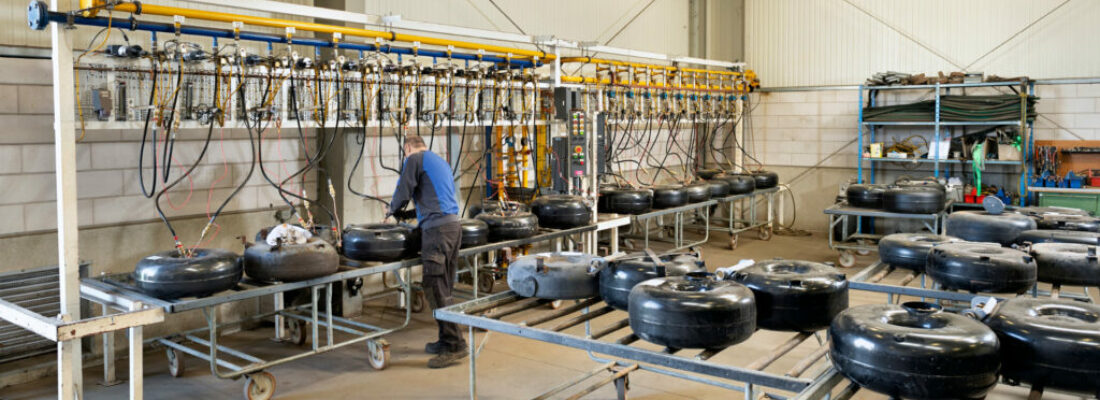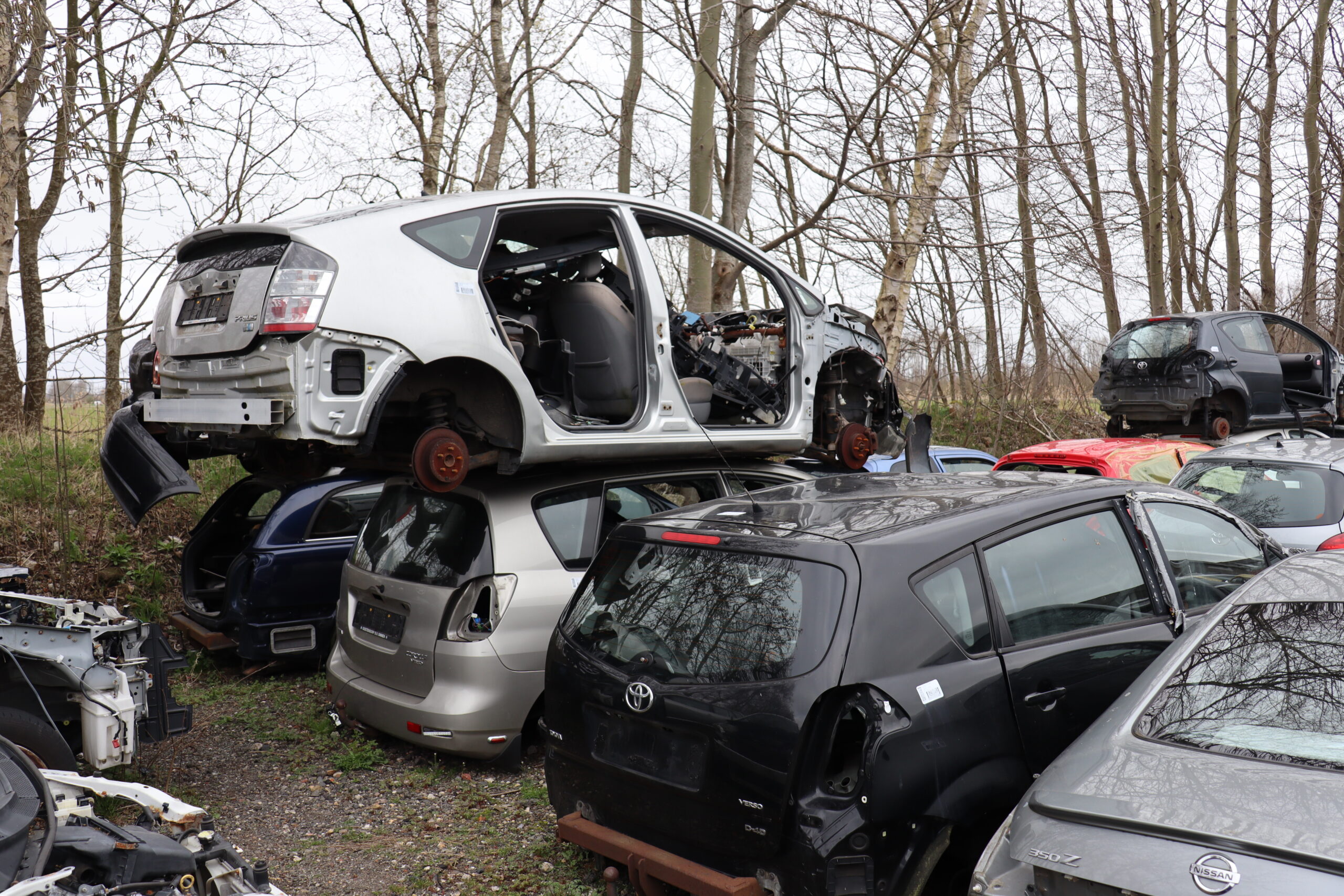In Waalwijk, ARVO-tech recycles LPG tanks and small gas containers in a unique way to obtain renewable raw materials. There, pumped-out and stripped LPG tanks also get a new lease on life and the reclaimed LPG is reused. Hazardous and difficult? Not if you use the tried and tested method developed by owner and general manager Ton Aarts.
Tekst Sjaak van Hal
Fotografie Verse Beeldwaren
“Why don’t you join me for a walk through the hall and across the grounds first,” Aarts suggests. “Straight away, that will give you a good idea of what it is we do here.” Immediately evident are the extensive safety measures referred to by various signs and posted instructions. We’re not even allowed to bring mobile phones into the dismantling hall. This is no exaggerated precaution, says Aarts, as the combination of gas, oxygen and a spark is an explosive one.
Gas detection system
In the dismantling hall, we detect a faint scent of gas. It’s nothing to worry about, Ton Aarts assures us: the smell is actually a non-flammable odour additive. “As soon as the gas detection system here measures a level higher than the LEL (Lower Explosive Limit) of ten per cent, an alarm will sound and all installations – both indoors and outdoors on the premises – will be automatically shut off and powered down while the building is evacuated.” Aarts points out the detection system’s gas sensors, which have been installed just above floor level in the hall. LPG is heavier than air and, in case of leaks, will start to build up down by the ground. “We’ve never had an accident here and we’d like to keep it that way. Which is why the newly-delivered tanks are stored outdoors in a separate place on the grounds and at the end of every workday, we create an inventory of which tanks are where. That way, in the event of an unexpected calamity, we’ll be able to provide emergency services with accurate information right away.”
Gas-purging process
Aarts escorts us into the heart of his business: the gas-purging installation. “We don’t milk cows here, we milk LPG tanks,” he says with a grin. And sure enough, the wheezing and pumping equipment attached to various LPG tanks does indeed resemble a milking carrousel at a dairy farm. The liquid LPG bobbing in the viewing windows reinforces that association. “This is phase 1 of the gas-purging process,” Aarts explains. “Once the pipes and appendages are removed, we attach quick-connectors of our own design to each tank. Before the gas is pumped out, a ground wire is attached to the LPG tank to protect from sparks caused by static electricity. Next, the quick-connectors are used to introduce pressure to one end of the tank, so that the liquid LPG will run out the other end. The gas first moves through a system of underground pipes to an 8,000-litre sludge tank to be purified, after which we store the clean LPG in a 40,000-litre underground tank.
Explosive
It isn’t enough to simply pump the LPG out of the tanks in phase 1, Aarts explains. “Once the liquid gas has been removed from the tanks, we keep the suction going for another 45 minutes. And at that point, you still can’t start disassembling them yet because every tank will still contain a certain amount of vapour. If that vapour is exposed to oxygen, a highly explosive mixture will result. In other words, you simply can’t be too careful.”
Aarts demonstrates how, in phase 2 of the purging installation, the vapour residue in the tanks is reduced to a safe level. There, the tanks are ‘rinsed out’ using compressed air. The mixture of gas and air from the tanks is piped out and burnt off using a flare. The burner of this flare stack is fed by the LPG reclaimed from the 40,000-litre tank. Aarts: “While there’s always a minute quantity of vapour left behind after rinsing the tank, it will be under the 10% LEL threshold after phase 2, at which point the tank can be safely de-installed.”
“ARN is our largest client; they provide the transport while we take care of the entire logistical aspect”
ARVO-tech employees remove the pumps and contents gauges from the tanks and sort the materials into ferrous and non-ferrous categories. Pure brass from the appendages is set apart, while ‘dirty brass’ from the pumps and contents gauges (which then goes to another recycling company for processing) is placed in a separate container. The dismantled steel tanks are stored on an outdoor lot in the same steel cages that ARN used to have them transported to Waalwijk in the first place.
Pure profit for the environment
ARVO-tech cooperates closely with ARN in the recycling of the LPG tanks. Aarts: “They are a major, and important, client. We oversee the entire chain of LPG recycling and logistics, end-to-end. The costs are covered by the collective waste disposal fees managed by ARN. According to Aarts, recycling LPG tanks and other gas containers offers major environmental benefits. “It cuts both ways, in fact. Of the tanks and parts that are scrapped, nearly 100% are reused. On top of that, you have the LPG tanks that we return to car dismantling companies. These tanks are marked with a return label and a dot of blue paint to distinguish them so they can be stored separately. All recyclable materials are sent to a regular buyer and there is virtually no residual waste: less than one per cent.
“We use the reclaimed LPG to heat our buildings and the rest is sold back to the trade”
The reclaimed LPG is pure profit for the environment as well. We use this gas to heat our buildings and the rest is sold back to the trade as fuel for cars, forklifts and other purposes. As a result, our company hasn’t had to purchase any natural gas in years. It would be fair to say we run almost completely on recycling.”
The ‘gasman’
It’s no coincidence that Ton Aarts came to specialise in the recycling of LPG tanks and gas containers. He has a technical background as a car mechanic and later workshop supervisor, and wound up in the gas industry via his in-laws. In 1998, he started his own business in Moergestel under the name ARVO-tech. The company initially developed and installed gas pipeline and appendage systems, including those for gas facilities at campsites. Then, in 2002, Aarts heard that Essent was looking to divest itself of its gas recycling company, Veracom B.V. in Waalwijk. Having developed into a true ‘gasman’ by then, the business struck Aarts as a fine addition to his existing activities.
Today, he runs a combined business at a location on the Duikerweg in Waalwijk: a company that recycles gas tanks and containers, and one that designs and builds custom solutions for any gas-related activity you can imagine. ARVO-tech recycles some 5,000 LPG tanks each year, which is equal to 5 per cent of the total volume recycled by the company, while the remaining 95 per cent comes from small gas containers and bottles. In the early years, when LPG use was at its peak, these figures were precisely the other way round. Aarts: “It’s important to keep ahead of developments in the market at all times, which is why we are constantly exploring new activities. Take the shiny stainless tanks over there, for instance: we supply those to car companies for the storage of coolant reclaimed from old air conditioners. That’s yet another environmentally-friendly endeavour based on recycling.”






